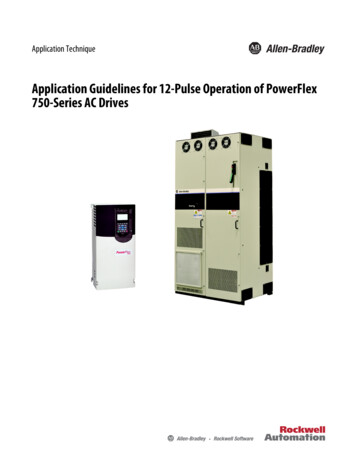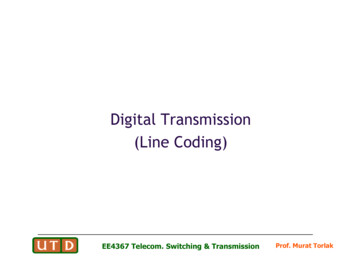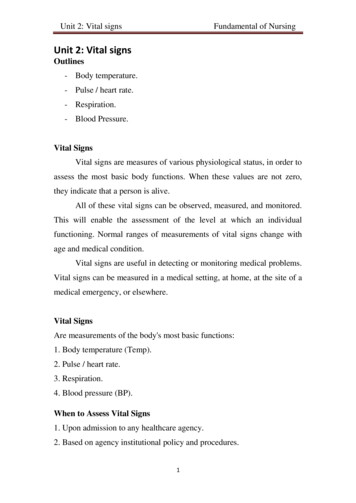
Transcription
Chapter 6: Pulse-Charging Battery SystemsNote: If you are not at all familiar with basic electronics, you might find it easier to understand this chapter if youread chapter 12 first.It is possible to draw substantial amounts of energy from the local environment and use that energy to chargebatteries. Not only that, but when this method of charging is used, the batteries gradually get conditioned to thisform of non-conventional energy and their capacity for doing work increases. In addition, about 50% of vehiclebatteries abandoned as being incapable of holding their charge any longer, will respond to this type of chargingand revive fully. This means that a battery bank can be created at very low cost.However, while this economic angle is very attractive, using batteries for any significant home application is justnot practical. If you set up a new bank account and deposit 1000 in it, and when you come back to check on itsome days later, you discover that there is only 500 in it. You ask the bank to check this error and they informyou that there is no error, all banks only return half of what is deposited in any account. What would you think ofthat? But, that is exactly what a lead-acid battery does for you – it only returns half of the current which you feedinto it when charging it. In other words, you waste half of the power which you feed into a car battery. NiCad andthe more popular NiMh batteries return two thirds of what is fed into them. Capacitors and banks of supercapacitors are 100% efficient and lose nothing as unlike batteries, they are not a chemical process.It is recommended that batteries are not discharged more rapidly than a twenty hour period. This means that abattery rated at a capacity of 80 Amp-hours (80 AHr) should not be required to supply a current of more than 4amps. If you exceed that discharge rate, then the number of times that the battery can be charged anddischarged is cut back severely – something which you do not realise at the time, but discover later when thebattery needs to be replaced as it no longer holds a charge. This is a devastating restriction which pushes batteryoperation into the non-practical category, except for very minor loads like lights, TVs, DVD recorders and similarequipment with minimal power requirements.The main costs of running a home are those of heating/cooling the premises and operating equipment like awashing machine. These items have a minimum load capacity of just over 2 kW. It makes no difference to thepower requirement if you use a 12-volt, 24-volt or 48-volt battery bank. No matter which arrangement is chosen,the number of batteries needed to provide any given power requirement is the same. The higher voltage bankscan have smaller diameter wiring as the current is lower, but the power requirement remains the same.So, to provide a 2 kW load with power, requires a total current from 12-volt batteries of 2000 / 12 167 amps.Using 80 AHr batteries this is 42 batteries. Unfortunately, the charging circuits described below, will not normallycharge a battery which is powering a load. This means that for a requirement like heating, which is a day andnight requirement, there needs to be two of these battery banks, which takes us to 84 batteries. This is only for aminimal 2 kW loading, which means that if this is being used for heating, it is not possible to operate the washingmachine unless the heating is turned off. So, allowing for some extra loading like this, the battery count reaches,perhaps, 126. Ignoring the cost, and assuming that you can find some way to get over the acid problem, thesheer physical volume of this number of batteries is just not realistic for domestic installation and use. In passing,you would also need two inverters with a 2500 watt capabilityThe recent charging system shown by ‘UFOpolitics’ in chapter 3, provides a very good and simple chargingmethod which uses cold electricity. This can overcome the previous constraints imposed by using batteries,probably both with regards to current draw and with regards to recharging time. The Electrodyne Corp. staff whoexperimented extensively with the Tesla Switch circuitry, found that when a battery was fully conditioned to usecold electricity, that a battery could be disconnected, discharged independently to it’s full capacity, and then recharged completely in under one minute. That style of operation completely overcomes the objections to usingbattery banks to power household equipment of any power, but it takes a long time to achieve as conditioning is aslow process.Battery banks are used to power standard inverters which can look like this:6-1
The battery connects at the back, using very thick wires, and one or more mains sockets on the front provide apower supply similar to the mains, matching it in both voltage and frequency. There is one variety of invertercalled a “True Sine-Wave” inverter and costing much more than the ordinary non-sinewave inverters. Mostequipment works well on the ordinary variety. It is usually the power available from the battery bank which is thelimiting factor, combined with the long time taken to recharge the battery bank after use.John Bedini’s Battery-Charging System.John Bedini has designed a whole series of pulse-generator circuits, all based on the 1:1 multi-strand choke coilcomponent disclosed in his patent US 6,545,444Roger Andrews’ Switching System.The very neat switching arrangement used by John is shown in detail in the earlier patent US 3,783,550 issued in1974 where the same magnet-triggered boosting electromagnet pulse is used to power a whole series ofmovements. One of these is two magnetic spinning tops made to spin in a shallow dish:When the tops spin fast, they rise up the sloping base of the dish and spin near the outer edge. When they slowdown they move back towards the centre of the dish and that triggers the battery/transistor/electromagnet builtinto the base of the dish. The pulse from the electromagnet boosts the spin of the top, sending it back up the6-2
slope. This is a very neat arrangement as the transistor is off most of the time and yet the two tops keep spinning.Another of Roger’s systems is shown here:It operates in almost the same way, with a magnetic wheel rolling backwards and forwards along a curved track.At the lowest point, the electromagnet is triggered by the induced voltage in some of the turns of the coil,powering the transistor and boosting the magnetic roller on it’s way.Another Andrews device is the pendulum where the passing magnet of the pendulum triggers a boosting pulsefrom the solenoid, keeping the pendulum swinging. John Bedini has also used this mechanism for a pulsedbattery charging system and Veljko Milkovic has demonstrated that substantial mechanical power can beextracted from a lever which is powered by a pendulum.Andrews also shows a switching arrangement for a motor. This design is essentially the same as used by JohnBedini in many of his pulsing systems:Here, as the rotor magnet passes the curved electromagnet in the base, it switches on the two transistors which6-3
produce a pulse which keeps the rotor spinning and the tiny generator turning. Andrews produced this foramusement as the rotor appears to spin on it’s own without any drive power.As with the Andrews system, the Bedini rotor is started spinning by hand. As a magnet passes the triple-wound“tri-filar” coil, it induces a voltage in all three coil windings. The magnet on the rotor is effectively contributingenergy to the circuit as it passes the coil. One winding feeds a current to the base of the transistor via the resistor‘R’. This switches the transistor hard on, driving a strong current pulse from the battery through the second coilwinding, creating a ‘North’ pole at the top of the coil, boosting the rotor on its way. As only a changing magneticfield generate a voltage in a coil winding, the steady transistor current through coil two is unable to sustain thetransistor base current through coil one and the transistor switches off again.The cutting of the current through the coil causes the voltage across the coils to overshoot by a major amount,moving outside the battery rail by a serious voltage. The diode protects the transistor by preventing the basevoltage being taken below -0.7 volts. The third coil, shown on the left, picks up all of these pulses and rectifiesthem via a bridge of 1000V rated diodes. The resulting pulsing DC current is passed to the capacitor, which isone from a disposable camera, as these are built for high voltages and very rapid discharges. The voltage on thecapacitor builds up rapidly and after several pulses, the stored energy in it is discharged into the “Charging”battery via the mechanical switch contacts. The drive band to the wheel with the cam on it, provides a mechanicalgearing down so that there are several charging pulses between successive closings of the contacts. The threecoil windings are placed on the spool at the same time and comprise 450 turns of the three wires (mark thestarting ends before winding the coil).The operation of this device is a little unusual. The rotor is started off by hand and it progressively gains speeduntil its maximum rate is reached. The amount of energy passed to the coil windings by each magnet on the rotorstays the same, but the faster the rotor moves, the shorter the interval of time in which the energy is transferred.The energy input per second, received from the permanent magnets, increases with the increased speed.If the rotation is fast enough, the operation changes. Up to now, the current taken from the ‘Driving’ battery hasbeen increasing with the increasing speed, but now the driving current starts to drop although the speedcontinues to increase. The reason for this is that the increased speed has caused the permanent magnet to movepast the coil before the coil is pulsed. This means that the coil pulse no longer has just to push against the ‘North’pole of the magnet, but in addition it attracts the ‘South’ pole of the next magnet on the rotor, which keeps therotor going and increases the magnetic effect of the coil pulse. John states that the mechanical efficiency of thesedevices is always below 100% efficient, but having said that, it is possible to get results of COP 11. Manypeople who build these devices never manage to get COP 1.It is important that a standard mains powered battery charger is never used to charge these batteries. It is clearthat the ‘cold electricity’ produced by a properly tuned Bedini device is substantially different to normal electricityalthough they can both perform the same tasks when powering electrical equipment. When starting to charge alead-acid battery with radiant energy for the first time, it is recommended that the battery is first discharged to atleast 1.7 volts per cell, which is about 10 volts for a 12 volts battery.It is important to use the transistors specified in any of John’s diagrams, rather than transistors which are listed asequivalents. Many of the designs utilise the badly named “negative resistance” characteristics of transistors.These semiconductors do not exhibit any form of negative resistance, but instead, show reduced positiveresistance with increasing current, over part of their operating range.It has been said that the use of “Litz” wire can increase the output of this device by anything up to 300%. Litz wireis the technique of taking three or more strands of wire and twisting them together. This is done with the wiresstretched out side by side, by taking a length of say, three feet, and rotating the mid point of the bundle of wiresfor several turns in one direction. This produces clockwise twists for half the length and counter-clockwise twistsfor the remainder of the length. Done over a long length of wire, the wires are twisted repeatedly clockwise counter clockwise - clockwise - counter clockwise - . along their whole length. The ends of the wires are thencleared of their insulation and soldered together to make a three-strand cable, and the cable is then used to windthe coils. This style of winding modifies the magnetic and electrical properties of the windings. It has been saidthat taking three long strands of wire and just twisting them together in one direction to make a long twisted threestrand cable is nearly as effective as using Litz wire. The websites www.mwswire.com/litzmain.htm and www.litzwire.com are suppliers of ready made Litz wire.A website which shows pictures of John’s devices is: www.rexresearch.com/bedini/images.htmCAUTION: Care must be taken when working with batteries, especially lead-acid batteries. A charged batterycontains a large amount of energy and short-circuiting the terminals will cause a very large current flow which maystart a fire. When being charged, some batteries give off hydrogen gas which when mixed with air is highlydangerous and which could explode if ignited by a spark. Batteries can explode and/or catch fire if grossly6-4
overcharged or charged with an excessively large current, so there could be danger from flying pieces of thecasing and possibly acid being thrown around. Even an apparently clean lead-acid battery can have caustictraces on the case, so you should be sure to wash your hands thoroughly after handling a battery. Batteries withlead terminals tend to shed small fragments of lead when clips are put on them. Lead is toxic, so please be sureto wash your hands after handling any part of a lead-acid battery. Remember too that some batteries can developslight leaks so please protect against any leakage. If you decide to perform any experiments using batteries, thatyou do so entirely at your own risk and on your own responsibility. This set of documents is presented forinformation purposes only and you are not encouraged to do anything other than read the information.Also, if you get one of John’s pulse motors tuned correctly, it will accelerate to perhaps 10,000 rpm. This is greatfor picking up energy but if ceramic magnets are used, the speed can cause them to disintegrate and fly in alldirections. People have had magnet fragments embedded in their ceiling. It would be wise to build a housingenclosing the rotor and magnets so that if the magnets disintegrate, all of the fragments are contained safely.Ronald Knight’s Professional Advice on Battery Safety.Ronald Knight has many years of professional experience in handling batteries and in pulse-charging them. Hecomments on battery safety as follows:I have not heard of anyone having a catastrophic failure of a battery case in all the energy groups to which Ibelong and most of them use batteries in the various systems which I study. However, that does not mean that itcannot happen. The most common reason for catastrophic failure in the case of a lead-acid battery, is arcingcausing failure in the grids which are assembled together inside the battery to make up the cells of the battery.Any internal arcing will cause a rapid build up of pressure from expanding Hydrogen gas, resulting in acatastrophic failure of the battery case.I am a former maintenance engineer for U.S. Batteries, so I can say with confidence, that when you receive a newbattery from at least that manufacturer, you receive a battery which has undergone the best test available toinsure the manufacturer that he is not selling junk which will be sent back to him. It is a relatively easy test, andas it takes place during the initial charge, there is no wasted time nor is there one battery that escapes the passor-fail test. The battery is charged with the absolute maximum current which it can take. If the battery does notblow up due to internal arcing during the initial charge it is highly likely that it will not blow up under the regular usefor which it was designed. However, all bets are off with used batteries that have gone beyond their expected life.I have witnessed several catastrophic failures of battery cases daily at work. I have been standing right next tobatteries (within 12 inches) when they explode (it is like a .45 ACP pistol round going off) and have only beenstartled and had to change my under shorts and Tyvek jump-suit, and wash off my rubber boots. I have been inthe charge room with several hundred batteries at a time positioned very closely together and have seen batteriesexplode almost every working day and I have never seen two side by side blow, nor have I ever seen one fire orany flash damage to the case or surrounding area as a result. I have never even seen a flash but what I haveseen tells me it is wise to always wear eye protection when charging.I have my new gel cells in a heavy plastic zip-lock bags partly unzipped when in the house and in a marinebattery box outside in the garage, that is just in the remote chance of catastrophic failure or the more likely eventof acid on the outside of the battery case.Vented batteries are always a risk of spillage which is their most common hazard, they should always be in aplastic lined cardboard or plastic box with sides taller than the battery and no holes in it. You would be surprisedat how far away I have found acid around a vented lead acid battery under charge.Have an emergency plan, keep a box of baking soda and a water source around to neutralise and flush the acid incase of spillage. It is best to have plastic under and around wherever your lead-acid batteries are located.Ronald Knight gets about fifteen times more power from his Bedini-charged batteries than is drawn from thedriving side of the circuit. He stresses that this does not happen immediately, as the batteries being charged haveto be “conditioned” by repeated cycles of charging and discharging. When this is done, the capacity of thebatteries being charged increases. Interestingly, the rate of current draw on the driving side of the circuit is notincreased if the battery bank being charged is increased in capacity. This is because the power which chargesthe batteries flows from the environment and not from the driving battery. The driving battery just produces thehigh-voltage spikes which trigger the energy flow from the environment, and as a consequence of that the batterybank being charged can be a higher voltage than the 12-volt driving battery, and there can be any number ofbatteries in the charging bank.6-5
Ron Pugh’s Battery Charger.John Bedini’s designs have been experimented with and developed by a number of enthusiasts. This in no waydetracts from fact that the whole system and concepts come from John and I should like to express my sincerethanks to John for his most generous sharing of his systems. Thanks is also due to Ron Pugh who has kindlyagreed for the details of one of his Bedini generators to be presented here. Let me stress again, that if you decideto build and use one of these devices, you do so entirely at your own risk and no responsibility for your actionsrests with John Bedini, Ron Pugh or anyone else. Let me stress again that this document is provided forinformation purposes only and is not a recommendation or encouragement for you to build a similar device.Ron’s device is much more powerful than the average system, having fifteen coil windings and it performs mostimpressively. Here is a picture of it rotating at high speed:This is not a toy. It draws significant current and produces substantial charging rates. This is how Ron chose tobuild his device. The rotor is constructed from aluminium discs which were to hand but he would have chosenaluminium for the rotor if starting from scratch as his experience indicates that it is a very suitable material for therotor. The rotor has six magnets inserted in it. These are evenly spaced 60 degrees apart with the North poles allfacing outwards.The magnets are normal ceramic types about 22 mm wide, 47 mm long and 10 mm high. Ron uses two of thesein each of his six rotor slots. He bought several spare ones and then graded all of them in order of their magneticstrength, which varies a bit from magnet to magnet. Ron did this grading using a gauss meter. An alternativemethod would have been to use a paper clip about 30 mm in size and measure the distance at which one end ofthe clip just starts to rise up off the table as the magnet is moved towards it:6-6
Having graded the magnets in order of strength, Ron then took the best twelve and paired them off, placing theweakest and strongest together, the second weakest and the second strongest, and so on. This produced sixpairs which have fairly closely matching magnetic strengths. The pairs of magnets were then glued in place in therotor using super glue:It is not desirable to recess the magnets though it is possible to place a restraining layer around the circumferenceof the rotor as the clearance between the magnet faces and the coils is about a quarter of an inch (6 mm) whenadjusted for optimum performance. The North poles of the magnets face outwards as shown in the diagramabove. If desired, the attachment of the magnets can be strengthened by the addition of blank side plates to therotor which allows the magnet gluing to be implemented on five of the six faces of the magnet pairs:6-7
The magnets embedded in the outer edge of the rotor are acted on by wound “coils” which act as 1:1transformers, electromagnets, and pickup coils. There are three of these “coils”, each being about 3 inches longand wound with five strands of #19 AWG (20 SWG) wire. The coil formers were made from plastic pipe of 7/8inch (22 mm) outer diameter which Ron drilled out to an inner diameter of 3/4 inch (19 mm) which gives a wallthickness of 1/16 inch (1.5 mm). The end pieces for the coil formers were made from 1/8 inch (3 mm) PVC whichwas fixed to the plastic tube using plumbers PVC glue. The coil winding was with the five wires twisted aroundeach other. This was done by clamping the ends of the five wires together at each end to form one 120 foot longbundle.The bundle of wires was then stretched out and kept clear of the ground by passing it through openings in a set ofpatio chairs. A battery-powered drill was attached to one end and operated until the wires were loosely twistedtogether. This tends to twist the ends of the wires together to a greater extent near the end of the bundle ratherthan the middle. So the procedure was repeated, twisting the other end of the bundle. It is worth remarking inpassing, that the drill turns in the same direction at each end in order to keep the twists all in the same direction.The twisted bundle of wires is collected on a large-diameter reel and then used to wind one of the “coils”.The coils are wound with the end plates attached and drilled ready to screw to their 1/4 inch (6 mm) PVC bases,which are the bolted to the 3/4 inch (18 mm) MDF supporting structure. To help the winding to remain completelyeven, a piece of paper is placed over each layer of the winding:6-8
The three coils produced in this way were then attached to the main surface of the device. There could just aseasily have been six coils. The positioning is made so as to create an adjustable gap of about 1/4 inch (6 mm)between the coils and the rotor magnets in order to find the optimum position for magnetic interaction. Themagnetic effects are magnified by the core material of the coils. This is made from lengths of oxyacetylenewelding wire which is copper coated. The wire is cut to size and coated with clear shellac to prevent energy lossthrough eddy currents circulating inside the core.The coils are positioned at equal intervals around the rotor and so are 120 degrees apart. The end pieces of thecoil formers are bolted to a 1/4 inch (6 mm) PVC base plate which has slotted mounting holes which allow themagnetic gap to be adjusted as shown here:6-9
The three coils have a total of fifteen identical windings. One winding is used to sense when a rotor magnetreaches the coils during its rotation. This will, of course happen six times for each revolution of the rotor as thereare six magnets in the rotor. When the trigger winding is activated by the magnet, the electronics powers up allof the remaining fourteen coils with a very sharp, pulse which has a very short rise time and a very short fall time.The sharpness and brevity of this pulse is a critical factor in drawing excess energy in from the environment andwill be explained in greater detail later on. The electronic circuitry is mounted on three aluminium heat sinks, eachabout 100 mm square. Two of these have five BD243C NPN transistors bolted to them and the third one has fourBD243C transistors mounted on it.The metal mounting plate of the BD243 transistors acts as its heat sink, which is why they are all bolted to thelarge aluminium plate. BD243C transistors look like this:The circuit has been built on the aluminium panels so that the transistors can be bolted directly on to it, andprovided with insulating strips mounted on top of it to avoid short circuits to the other components. Standard stripconnector blocks have been used to inter-connect the boards which look like this:6 - 10
The circuit used with this device is simple but as there are so many components involved, the diagram is split intoparts to fit on the page. These diagrams are usually drawn with a common charging wire going to the top of thebattery which is being charged. However, it needs to be understood that drawing it that way is just forconvenience and better performance is achieved if each charging circuit has its own separate wire going to thecharging battery as shown in Section 1 here:6 - 11
6 - 12
While this looks like a fairly large and complicated circuit, it actually is not. You will notice that there are fourteenidentical circuit sections. Each of these is quite simple:This is a very simple transistor circuit. When the trigger line goes positive (driven by the magnet passing the coil)the transistor is switched on hard, powering the coil which is then effectively connected across the driving battery.The trigger pulse is quite short, so the transistor switches off almost immediately. This is the point at which thecircuit operation gets subtle. The coil characteristics are such that this sharp powering pulse and sudden cut-offcause the voltage across the coil to rise very rapidly, dragging the voltage on the collector of the transistor up toseveral hundred volts. Fortunately, this effect is energy drawn from the environment which is quite unlikeconventional electricity, and thankfully, a good deal less damaging to the transistor. This rise in voltage,effectively “turns over” the set of three 1N4007 diodes which then conducts strongly, feeding this excess freeenergy into the charging battery. Ron uses three diodes in parallel as they have a better current-carrying capacityand thermal characteristics than a single diode. This is a common practice and any number of diodes can beplaced in parallel, with sometimes as many as ten being used.The only other part of the circuit is the section which generates the trigger signal:6 - 13
When a magnet passes the coil containing the trigger winding, it generates a voltage in the winding. The intensityof the trigger signal is controlled by passing it through an ordinary vehicle 6 watt, 12 volt bulb and then furtherlimiting the current by making it pass through a resistor. To allow some manual control of the level of the triggersignal, the resistor is divided into a fixed resistor and a variable resistor (which many people like to call a “pot”).This variable resistor and the adjustment of the gap between the coils and the rotor are the only adjustments ofthe device. The bulb has more than one function. When the tuning is correct, the bulb will glow dimly which is avery useful indication of the operation. The trigger circuit then feeds each of the transistor bases via their 470ohm resistors.John Bedini aims for an even more powerful implementation, wiring his circuit with AWG #18 (19 SWG) heavyduty copper wire and using MJL21194 transistors and 1N5408 diodes. He increases the trigger drive by droppingthe variable resistor and reducing fixed resistor to just 22 ohms. The MJL21194 transistor has the same pinconnections as the BD243C transistor. This is the starting section of John’s circuit:There are various ways of constructing this circuit. Ron shows two different methods. The first is shown aboveand uses paxolin strips (printed-circuit board material) above the aluminium heat sink to mount the components.Another method which is easy to see, uses thick copper wires held clear of the aluminium, to provide a clean andsecure mounting for the components as shown here:6 - 14
It is important to realise that the collector of a BD243C transistor is internally connected to the heat-sink plateused for the physical mounting of the transistor. As the circuit does not have the collectors of these transistorsconnected together electrically, they cannot just be bolted to a single heat-sink plate. The above picture mightgive the wrong impression as it does not show clearly that the metal bolts fastening the transistors in place do notgo directly into the aluminium plate, but instead, they fasten into plastic tee-nuts.An alternative, frequently used by the builders of high-powered electronic circuits, is to use mica washers betweenthe transistor and the common heat sink plate, and use plastic fastening bolts or metal bolts with a plasticinsulating collar between the fastening and the plate. Mica has the very useful property of conducting heat verywell but not conducting electricity. Mica “washers” shaped to the transistor package are available from thesuppliers of the transistors. In this instance, it seems clear that heat dissipation is not a problem in this circuit,which in a way is to be expected as the energy being drawn from the environment is frequently called “cold”electricity as it cools components down with increasing
John Bedini’s Battery-Charging System. John Bedini has designed a whole series of pulse-generator circuits, all based on the 1:1 multi-strand choke coil component disclosed in his patent US 6,545,444 Roger Andrews’ Switching System. The very neat switching arrangement used by John is sho










